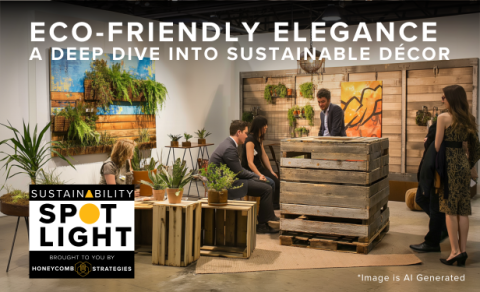Eco-Friendly Elegance: A Deep Dive into Event Décor

Exclusively sponsored by Honeycomb Strategies
In today’s world, exhibiting at events sustainably is not a trend but a responsible choice. From eco-friendly carpets and flooring to recycled furniture, innovative signage and creative balloon alternatives, we delve into how sustainable choices can elevate your event’s style while reducing environmental impact.
Carpet
Event carpet has become a standard way to transform large, impersonal spaces into intimate environments. Unfortunately, carpet production requires petroleum-based chemicals for backing and adhesives, substantial water for dyeing and energy for manufacturing. As these materials break down in landfills, carpets release harmful substances, such as volatile organic compounds (VOCs), phthalates, flame retardants and formaldehyde, which pose environmental and health risks as they leach into soil and groundwater.
If sustainability is a priority, go without booth flooring altogether. If you use flooring, evaluate carpet choices. Depending on the provider, standard and classic cut carpet have recycled content and are washed for reuse in multiple events. Avoid custom cut carpet, premium colors (including white), padding and vinyl flooring, which cannot be reused or recycled.
Try an alternative: Reusable flooring solutions, like lightweight bamboo, recycled rubber or modular carpet tiles, provide a polished feel and can be used over and over again.
Signage
Signage is important to communicate information, branding, fulfill sponsorships and engage attendees. Unfortunately, common materials, like fabrics, foam core or vinyl banners can contain harmful chemicals, can be difficult to reuse and are often sent directly to landfill.
Always design printed signage for reuse. A best practice is to procure paper-based materials with at least 50% recycled content and that can easily be recycled. We recommend looking into alternative inks, like soy ink, water-based and vegetable-based inks, which are designed to contain fewer VOCs, heavy metals and chemicals, and take less energy to create than conventional ink.
Try an alternative: Digital signage that can be switched off when not in use is a great alternative to printed signage when it needs to convey information like dates, times, hashtags or branding that render the signage to one-time use.
Balloons
Balloons can be harmful to the environment, primarily due to the materials they are made of and their disposal. Most balloons are made of latex or Mylar (metallic polyester) — neither of which are biodegradable and can persist in the environment for a long time if released outdoors. When balloons end up in natural habitats or waterways, they can be mistaken for food by wildlife, leading to ingestion and potential harm or death. Plus, balloons contribute to littering, impacting ecosystems and wildlife habitats and the liveability of human neighborhoods.
Try an alternative: Use paper or natural fibers to construct sculptural décor, incorporate potted plants as a pop of color and literal fresh air, try projectors and virtual images or get creative with upcycled art that can be constructed sculpturally or decoratively.
Furniture
Embrace rental furniture. This popular and widely available system reduces carbon emissions from transportation. Since furniture manufacturing uses resources, like wood, metals, plastics, foam, textiles and energy, extending the life of a chair or sofa beyond a single use ensures these resources are not unnecessarily depleted.
If you plan to leave your furniture behind, investigate donation programs, frequently overseen by the event management team or the venue in an effort to divert excess material from the landfill, support local charities and give furniture a long second life.
Try an alternative: Use your shipping containers as your furniture. We’ve seen effective and attractive trade show exhibits that use packing crates as tables, reducing storage costs during the event, lowering the weight and cost of shipped materials and providing a valuable conversation starter to passersby.
Designed for Impact
With a bit of thought, sustainable design can save money without compromising the look and feel of the event. Plan early with your booth designer and contractor to select materials that are not only more eco-friendly but also still meet your needs. Then, identify end-of-use plans for everything you bring to an event to ensure sustainable materials can be reused, donated or upcycled before disposal.


Add new comment